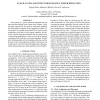Free Online Productivity Tools
i2Speak
i2Symbol
i2OCR
iTex2Img
iWeb2Print
iWeb2Shot
i2Type
iPdf2Split
iPdf2Merge
i2Bopomofo
i2Arabic
i2Style
i2Image
i2PDF
iLatex2Rtf
Sci2ools
FPL
2009
Springer
2009
Springer
Clock gating architectures for FPGA power reduction
Clock gating is a power reduction technique that has been used successfully in the custom ASIC domain. Clock and logic signal power are saved by temporarily disabling the clock signal on registers whose outputs do not affect circuit outputs. We consider and evaluate FPGA clock network architectures with built-in clock gating capability and describe a flexible placement algorithm that can operate with various gating granularities (various sizes of device regions containing clock loads that can be gated together). Results show that depending on the clock gating architecture and the fraction of time clock signals are enabled, clock power can be reduced by over 50%, and results suggest that a fine granularity gating architecture yields significant power benefits.
Clock | Clock Gating | Clock Gating Capability | FPL 2009 | Hardware |
| Added | 24 Jul 2010 |
| Updated | 24 Jul 2010 |
| Type | Conference |
| Year | 2009 |
| Where | FPL |
| Authors | Safeen Huda, Muntasir Mallick, Jason H. Anderson |
Comments (0)

